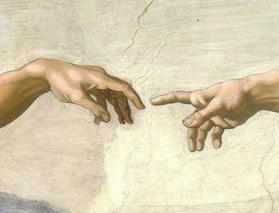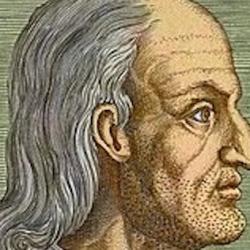I found several reviews (and partial reviews) of articles and books on my hard drive, and will post them here. Some of them were posted on a now-defunct web site, so this will make them available on the web, for those who know that this site exists!
John Milbank, “The Soul of Reciprocity Part One: Reciprocity Refused,” Modern Theology 17:3 (July 2001): 334-391.
Like everything that Milbank writes, this is a dense and difficult article. In essence, it is the first part of an effort to provide an account of the soul as an alternative both to the modern Cartesian subject and to the postmodern dissolution of the subject. For Milbank, to offer “soul” as the alternative to “subject” means highlighting the priority of reciprocity. Minimally, this means that my self is formed by interaction with others, just as the others I encounter are formed through interaction with me. I am what I am through exchanges with others, and they are what they are partly through interchanges with me. As Milbank explains, this interaction involves a sharing “of specific concrete goods in the context of a society seeking to orientate itself towards justice, and therefore recommending specific roles and specific virtues to its members” (p. 343). That is, this is not simply interaction between a naked, contentless I and an equally naked, contentless Thou; it is a exchange of gift and returned gift that takes place within a particular set of practices and within a community that has a particular shape and organization. To speak of man as soul is to say that this exchange within particular settings is what makes a man what he is. This, it may be clear, indicates that Milbank is not only offering an account of the nature of the self but also an account of charity. Modernity (“reciprocity refused”) has no place for the soul, and hence no place for charity.
Perhaps an Augustinian example will clarify. In the Preface to On Christian Teaching , Augustine explains the importance of the fact that God uses human teachers within the church to communicate His word, rather than simply revealing Himself to each member individually: “there would be no way for love, which ties people together in the bonds of unity, to make souls overflow and as it were intermingle with each other, if human beings learned nothing from other humans.” To shade this toward Milbank’s terminology, the reciprocal exchange of knowledge leads to an intermingling of souls that forms each of the souls involved in the exchange.
I don’t intend here to summarize the whole of Milbank’s article, much less to critique it. I don’t understand enough to do either. But in the course of giving an account of soul, Milbank offers a number of important and fairly straightforward perspectives and arguments, especially in the initial pages of the article. In what follows, I attempt to summarize a few of these.
1) Milbank argues that the mind-body problem was created by the evacuation of spirit from the world. Though he doesn’t mention it, early modern science, with its mechanistic models of nature, helped form an idea of the natural world as devoid of spirit. This set the stage for dualistic accounts of man. It is not the idea of soul that produced a dualistic split but the modern subject, the product of “the Cartesian attempt to arrive at a stable compromise between a spiritless world, on the one hand, and the priority of spirit, on the other” (p. 336). For Aristotle and Aquinas, Milbank suggests, the “anima” within man “was in some continuity with the notion of animation in general, as spontaneous force in matter, irreducible to mechanical causation” (p. 336). To have a soul did not mean that there was some ghost enclosed within the body; instead, “Precisely as soul, the human being was . . . radically opened outwards in the very heart of its interiority to become ‘in a manner all things’” (p. 336).
This view of “soul” as the animating principle of all things seems to have some biblical support in Gen. 1, which indicates that all creatures with motion are living nephesh . Further, his idea that the world, and not merely man, is replete with Spirit is no more than the essentially creationist idea that all creation depends for its continuing existence on the Word and Spirit of God. Moreover, the idea of the soul as an opening out to the world also seems consistent with Scripture, which speaks of the soul (not merely the body) being weak with hunger, revived by food, affected by the events around it. At least, Milbank’s suggestion is closer to the biblical picture than the Cartesian view of the self as a “thinking thing” disengaged from the world and even from its own body.
2) One important implication of this view of soul is that “what we today tend to think of as objective and subjective were thoroughly confused” in ancient and medieval philosophy (p. 337). In the modern mechanistic universe, knowledge occurs when the subject directs his mind toward objects that are passive awaiting the subject’s gaze. In a world alive with spirit, the object is not passively waiting to be known, but must make itself known. As Milbank puts it,
it is not that mind simply beams a light upon things; for while it does illuminate, it is only able to do so because it meets an answering beam coming from things themselves. If we are conscious and aware of being conscious, then we cannot separate this power from the power of things to come to consciousness. Consciousness, then, like psyche, is prior to the subjective-objective division, and is an ontological, before it is a psychological or epistemological matter . . . . “External” things as well as minds contribute to consciousness, and bodies mediate this double source (p. 338).
Milbank is anticipated in this regard by Augustine. In his treatise On the Trinity , Augustine says that things and the mind are “co-generators” of thought: “Evidently . . . we must hold that every single thing whatsoever that we know co-generates in us knowledge of itself; for knowledge issues from both, from the knower and the thing known” (9.3.18). Similarly, sensible experience is a product not merely of the senses, but of the thing sensed:
So sight is begotten of the visible thing but not from it alone; only if there is a seeing subject present. Sight then is the product of the visible object and the seeing subject, where the seeing subject of course provides the sense of the eyes and the intention of looking and holding his gaze; but the information of the sense, which is called sight, is imprinted on it only by the body which is seen, that is by some visible thing (11.1.3).
Notice in both quotations that the object makes an “active” contribution to the knower’s knowing.
These seem to be obvious points perhaps but they strike at the foundations of modern philosophy. Descartes’s pure subject, a subject abstracted from every object, a mind that is nothing more than a thinking thing that is thinking of nothing in particular, is impossible.
3) Milbank argues that the postmodern attack on Descartes, which Milbank associates with Spinoza, is simply a shift within what remains a Cartesian perspective. In one sense, Spinoza restored the soul, since he placed “the subject back within the flux of events: events as logical are already somewhat ‘psychic,’ while the soul knows only by actively rearranging reality” (p. 340). That’s a good move, since it means that the self is seen as embedded in real time and history. Ultimately, however, Spinoza and his contemporary heirs do not escape Descartes. For postmodernism, everything is mad
e immanent, everything is locked within the ever-changing flow of time; there is no God above and outside the flux, nor even any Platonic world of forms. But “if the confinement of being to immanence and temporal flux clearly appears, then one must assume that it appears to a reserved meta-subject, not caught up within the flux at all” (p. 340). In other words, if Spinoza can see that everything is flux only if he is somehow positioned above the flux. This shows that the Spinozists’ claim that “everything is caught up in flux” is self-refuting, but also shows that Spinoza is sitting right beside Descartes, in midair, detached from the world.
On the other hand,
the various shifting identities taken on by subjects caught up inside the flux of events [in the postmodern view] are evanescent, since they do not participate in eternal, true identities within the Logos of God. Since these subjects are only subjects of change, in so far as they remain subjects they are also, after all, just like the observing meta-subject, emptily self-identical (substantive within qualities) and punctiliar modern subjects (p. 340).
Since the postmodern self is an ever-shifting self without any permanent or fixed identity, he is in himself simply empty, which again reminds us strongly of the Cartesian self. There is one final escape for the postmodern: the subject could “dissolve altogether into flux,” but this ultimately doesn’t get away from Descartes either, since “this supposed pure dissolution into objective flux must be observable by the privileged meta-subject” (pp. 340-341).
There is much more to glean from this suggestive article, but that is doubtless enough to puzzle, bewilder, or, one hopes, stimulate.











